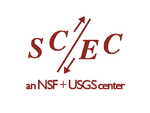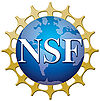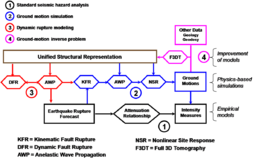Difference between revisions of "CME Project"
| Line 1: | Line 1: | ||
| − | [[Image:SCEC_NSF-USGS-words_logom.png|right| | + | [[Image:SCEC_NSF-USGS-words_logom.png|left|150px]][[Image:nsf1.jpg|right|100px]][[Image:usgs-logo-color.jpg|right|150px]] |
| − | + | == Community Modeling Environment (CME) == | |
| + | The SCEC Community Modeling Environment (CME) Project started in 2001 as a National Science Foundation (NSF) Information Technology Research (ITR) award to PI: Thomas Jordan, Bernard Minster, Carl Kesselman, and Reagan Moore. The CME collaboration applies advanced computer science technology to develop improved seismic hazard analysis. | ||
CME researchers develop structural models of California faults and geology, develop and validate rupture physics models, perform large-scale regional wave propagation simulations, collaborate with engineers studying engineering response to ground motions, and integrate computational improvements into probabilistic seismic hazard calculations. | CME researchers develop structural models of California faults and geology, develop and validate rupture physics models, perform large-scale regional wave propagation simulations, collaborate with engineers studying engineering response to ground motions, and integrate computational improvements into probabilistic seismic hazard calculations. | ||
| + | |||
| + | == Collaborative Project Entries == | ||
| + | The following link will take you to an alphabetically sorted list of all SCECpedia pages. | ||
| + | *[http://scec.usc.edu/scecpedia/Special:AllPages List of All SCECpedia Pages] | ||
| + | |||
| + | [[File:pathways.png|256px|thumb|right|Fig 1: SCEC/CME computational pathways provide a scientific framework for improving seismic ground motion forecasts. The SCEC/CME Project began as an NSF information technology research (ITR) project in 2001. (Image Credit: Thomas H. Jordan) ]] | ||
| + | |||
| + | |||
| + | |||
| + | |||
== CME Project Pages == | == CME Project Pages == | ||
Revision as of 06:05, 22 April 2017
Contents
- 1 Community Modeling Environment (CME)
- 2 Collaborative Project Entries
- 3 CME Project Pages
- 4 Related SCEC Web Sites
- 5 CME Science and IT Collaborators Web Sites
- 6 SCEC Computer Science Collaborative Organizations and Resource Providers
- 7 Related Research Areas
- 8 CME Software
- 9 Supercomputing
- 10 CME Studies
- 11 SCEC Computer Science Collaborative Organizations and Resource Providers
- 12 See Also
- 13 Recent Earthquake Information
- 14 License
Community Modeling Environment (CME)
The SCEC Community Modeling Environment (CME) Project started in 2001 as a National Science Foundation (NSF) Information Technology Research (ITR) award to PI: Thomas Jordan, Bernard Minster, Carl Kesselman, and Reagan Moore. The CME collaboration applies advanced computer science technology to develop improved seismic hazard analysis. CME researchers develop structural models of California faults and geology, develop and validate rupture physics models, perform large-scale regional wave propagation simulations, collaborate with engineers studying engineering response to ground motions, and integrate computational improvements into probabilistic seismic hazard calculations.
Collaborative Project Entries
The following link will take you to an alphabetically sorted list of all SCECpedia pages.
CME Project Pages
- M8
- Broadband Platform
- CVM Toolkit
- Goodness of Fit
- SCEC Visualization Projects
- CyberShake
- PetaSHA3 Project
- CSEP
- SCEC Software
- PetaShake Project
- PetaSHA1 Project
- PetaSHA2 Project
- PetaSHA3 Project
- Outward on the Spiral Project
- SEISM Project
- PressOn Project
Related SCEC Web Sites
CME Science and IT Collaborators Web Sites
- SCEC Broadband Platform
- Toolkit CVM Toolkit
- OpenSHA Software
- USR/CVM-H
- SCEC-VDO Software and SCEC-VDO video
- SCEC Websims Data Management Site
- SCEC CSEP Testing Center
- CME Movies and Animations
SCEC Computer Science Collaborative Organizations and Resource Providers
- SDSC
- SDSC HPGeoC
- SDSC Visualization Services
- Scientific Workflows at USC/ISI
- Fault Tolerant Computing at CSM
- USC HPCC
- PSC
- NICS
- NCCS
- TACC
- NCSA
- Blue Waters
- Open Science Grid
Related Research Areas
- CISN
- SCEC Dynamic Rupture Group
- Global Earthquake Model (GEM)
- Collaborative Climate Forecast Modeling
CME-related web sites
- OpenSHA Software
- USR/CVM-H
- SCEC-VDO Software and SCEC-VDO video
- SCEC Broadband Platform
- SCEC Websims Data Management Site
- SCEC CSEP Testing Center
- CME Movies and Animations
SCEC Computer Science Collaborative Organizations and Resource Providers
- SDSC
- SDSC HPGeoC
- SDSC Visualization Services
- Scientific Workflows at USC/ISI
- Fault Tolerant Computing at CSM
- USC HPCC
- PSC
- NICS
- NCCS
- TACC
- NCSA
- Blue Waters
- Open Science Grid
Related Research Areas
- E-Trees
- CME Project
- Geoinformatics Project
- Geoinformatics Phase II Project
- High-F Project
- SEISM Project
- SEISM2 Project
- PetaSHA3 Project
- High-F
- CyberShake Project
- UCERF3
- UCVM
- UCERF3
- F3DT
- UCVM
- CCA
- CyberShake Study 15.10
- ABZ2015
- VirtualBox_Configuration
- UCVM Meshing
- Duration
- NSCI
- ORCID
- CyberShake_Review_Process
- SCEC Structure
- SEISM2 Project
- CFM
- Data Quality
- INCITE 2016
- AGU Fall 2015
- Data Citation Levels
- AWP-ODC-FDQ
- SCEC_Web_Development_Home_Page
- Broadband Platform
- Comparison of Compute Nodes
- High-F Project
- CyberShake Project
- Central California Velocity Model
- EMI Conference
- HighF_v14.12_Data_Comparison
- SCEC_Site_Effects_Workshop_2015
- SCEC_UGMS_Committee_Meeting_4
- UGMS
- 3D Modeling
- 2015 SCEC SSI Workshop
- Evaluation of SCEC Broadband Platform Phase 1 Ground Motion Simulations Results
- 2014 SCEC-ERI Summer School for Earthquake Science
- CFM-5
- SCEC AM 2014
- IDC Award Notice Nov. 2013
- NCEE Meeting 2014
- OLCF Users Meeting
- Chino Hills 1D and 3D
- UseIT
- SSA
- SCEC Data Storage
CME Software
- Broadband Platform
- UCVM 14.3.0
- UCERF3.0
- CSEP Distribution
- CVM-S5
- SI2 Meeting 2015
- AWP-ODC
- CVM-S5
- CVM-H
Supercomputing
CME Studies
- CyberShake Study 14.2
- UCVM_v14.3
- Northridge 10Hz
- SCEC UGMS Committee Meeting
- SI2 PI Meetings
- CISN
- SCEC Software
- CyberShake 1D Model
- UCVM
- SWUS Project
- Hadley-Kanamori
- Northridge 10Hz
- Earthquake Simulation Animations
- SSA
- Credits
- CMM4
- AGU
- SC
- SC13 SC'13 Denver
- SC12 SC'12 Salt Lake City
- UCERF3 Extended Earthquake Rupture Forecast
- CVM-S4.26 Proposed Final Model
- MFA
- GTL
- ShakeOut 2013 Response Planning
- UCVM 13.9.0
- CVM-H
- CISN Testing Center
- AWP ODC GPU
- SCEC Technical Activity Groups
- Related Project Sites
- Staff
- Wiki Statistics
- Usability
- XSEDE/PRACE Workflow Workshop
- California CVM Meeting - 3 April 2012
- Data Management
- SCEC Visualization Projects
- Cloud Computing
- Geoinformatics Project
- NWSC ASD
- CME Project
- Broadband Platform
- ALCF Early Science Program Investigators Meeting
- XSEDE13 Meeting Web Site - San Diego, California
- SC13 Meeting Web Site - Denver, Colorado
- CyberShake Study 13.4
- Software Metrics
- CME Project
- Dublin Core Metadata
- UCVM
- CVMS4 versus CVMSI22 plots
- UCERF3 Images
- CyberShake Wiki - Internal
- SCECpedia Public Wiki
- Broadband Platform
- Broadband Release Info
- Broadband Internal Wiki
- Broadband User Guide v13.9.0
- Production Run Readiness Review
- Broadband Platform on HPCC
- Broadband Sprints
- Fling Study
- Broadband Platform on HPCC
- Broadband Validation Events
- Broadband Platform Meeting - 7 March 2012
- Broadband User Guide Current
- PEER Data Format
- Broadband Platform Working Group
- Blue Waters
- CyberShake
- Seismic Intensity
- Null Hypothesis
- IRC
- Public CME Website
- Collaborative SCEC Wiki
- SCEC Home Page
- SDSC High Performance Geocomputing Laboratory
- PetaSHA3 Project
- CME Movies and Animations
- CVM-Toolkit
- SCEC Websims Data Management Site
- SCEC CSEP Testing Center
SCEC Computer Science Collaborative Organizations and Resource Providers
- SDSC
- SDSC HPGeoC
- SDSC Visualization Services
- Scientific Workflows at USC/ISI
- Fault Tolerant Computing at CSM
- USC HPCC
- PSC
- NICS
- NCCS
- TACC
- NCSA
- Blue Waters
- Open Science Grid
- PetaSHA3 Project
- CME Scientific Software Projects
- SCEC People
- SCEC Special Projects
- SCEC Organizations
See Also
Additional information about SCEC earthquake system science research is available on related SCEC web sites including:
Recent Earthquake Information
An important goal of SCEC earthquake research is to reduce the hazard from future earthquakes by developing physics-based predictive models of earthquake processes.
License
Except as otherwise noted, the content of this page is licensed under the Creative Commons Attribution 3.0 Unported License, and code samples are licensed under the Apache 2.0 License. For details, see our Site Policies.
![]()



